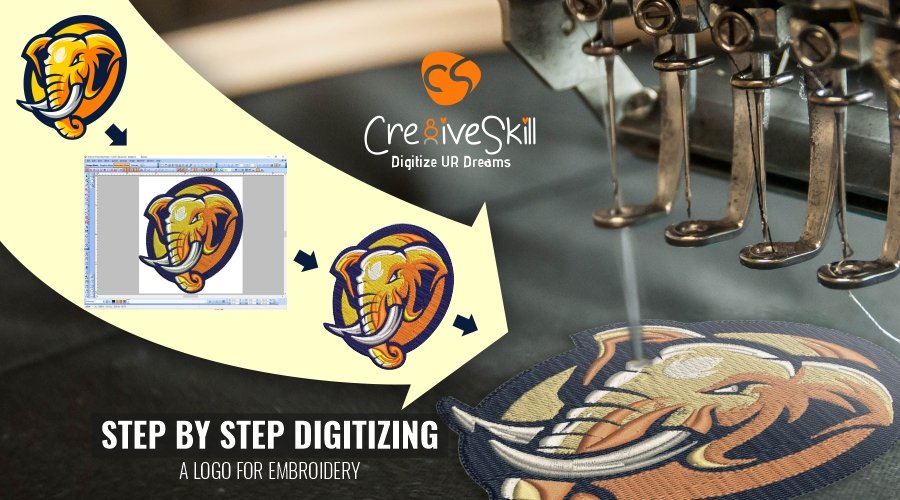Efficient Digitizing for Embroidery: Quick Turnaround
Efficient Digitizing for Embroidery: Quick Turnaround
Blog Article
Discover Different Kinds Of Needlework Digitizing Methods
Needlework digitizing has actually progressed significantly over the years, using a myriad of techniques to bring designs to life in the digital realm. From the elaborate artistry of traditional hand embroidery digitizing to the precision of the boxing method, and the ease of auto-digitizing software application programs, the options are vast. In addition, the world reaches advanced techniques like photorealistic needlework digitizing and the remarkable world of 3D embroidery digitizing. Each technique brings a distinct set of possibilities and obstacles to the table, making the expedition of these approaches an engaging journey for those in the embroidery globe.
Conventional Hand Embroidery Digitizing
Conventional hand embroidery digitizing includes the process of converting intricate hand-stitched designs right into digital layouts for device embroidery. This technique needs experienced craftsmens to carefully evaluate the handcrafted style and afterwards make use of specialized software program to recreate it in an electronic format. Each stitch, shade, and information needs to be thoroughly equated to guarantee that the significance of the initial hand needlework is protected in the electronic version.
Among the vital challenges of standard hand needlework digitizing is catching the intricacies and nuances of the handmade style. Digitizing for Embroidery. Artisans must have a deep understanding of different needlework methods, such as satin stitch, chain stitch, and French knots, to precisely replicate these strategies in the digital world. Furthermore, they need to have an eager eye for information to make certain that the digital style maintains the exact same degree of virtuosity and craftsmanship as the original hand-stitched piece
Punching Strategy
To flawlessly shift from standard hand needlework digitizing to the boxing strategy, craftsmens must currently focus on transforming the detailed electronic styles right into directions that embroidery makers can interpret. The boxing strategy includes using specialized software program to create digital data which contain commands for the embroidery equipment to follow. This procedure requires a deep understanding of not simply the layout itself but additionally the capacities and constraints of the embroidery equipment.

Auto-Digitizing Software Application Programs
Embroidery digitizing has been reinvented by the arrival of auto-digitizing software programs, providing artisans with advanced devices to convert electronic layouts into embroidery device directions effectively. Auto-digitizing software application use algorithms to evaluate digital images or vector files and produce embroidery designs automatically. These programs permit quick and precise conversion of intricate styles into stitch patterns, conserving effort and time for embroiderers.
One of the vital advantages of auto-digitizing software application is its straightforward user interface, making it available to both newbies and seasoned digitizers. These programs frequently include features such as stitch modifying devices, string shade matching, and the capacity to sneak peek the last stitched style. In addition, auto-digitizing software application can manage complex designs with multiple colors and elaborate information, producing high-grade embroidery documents appropriate for different clothing and fabric tasks.
While auto-digitizing great site software program provides benefit and effectiveness, it is crucial for individuals to understand the restrictions of automated digitizing. Fine-tuning and hands-on changes might still be called for to attain the desired needlework top quality, specifically when dealing with intricate or one-of-a-kind styles. By leveraging the abilities of auto-digitizing software application along with hands-on digitizing techniques, artisans can enhance their embroidery digitizing process and produce magnificent embroidered items.
Photorealistic Needlework Digitizing
Using innovative digital imaging methods, achieving photorealistic cause embroidery digitizing has actually become an in-demand skill among modern-day craftsmens. This technique involves converting high-resolution pictures right into complex stitch patterns that very closely resemble the initial style, resulting in embroidery pieces that show natural information and deepness.
To attain photorealistic needlework digitizing, artisans must possess a keen eye for information and a comprehensive understanding of exactly how various stitch kinds and densities can impact the last result. By very carefully mapping out each color and color in the photo, embroiderers can develop a digital documents that overviews the needlework device to replicate the nuances of the initial image properly.
Photorealistic needlework digitizing is especially preferred in developing personalized designs for clothing, home decoration, and art pieces where capturing the significance of a picture or art work is crucial. This strategy allows craftsmens to transform memories, landscapes, portraits, and detailed artwork right into stunning embroidered masterpieces that showcase a mix of typical craftsmanship and sophisticated technology.
3D Embroidery Digitizing
With the innovation of electronic imaging methods in achieving photorealistic outcomes in embroidery digitizing, the expedition of 'D Embroidery Digitizing' provides a new measurement to the browse around this web-site intricacies of layout replication. 'D Embroidery Digitizing' refers to the three-dimensional digitizing method that includes depth and structure to embroidery designs, developing an extra realistic and aesthetically appealing final product. This strategy utilizes software that simulates the result of light and darkness on the embroidery layout, boosting its total aesthetic influence.
One of the vital benefits of 'D Needlework Digitizing' is its capability to make styles look more realistic and vibrant. By including deepness to the embroidery style, the end product appears a lot more practical and click to read fascinating (Digitizing for Embroidery). Furthermore, this strategy enables even more imaginative liberty in layout implementation, enabling embroiderers to trying out different structures and effects that were formerly testing to attain
Verdict

Report this page